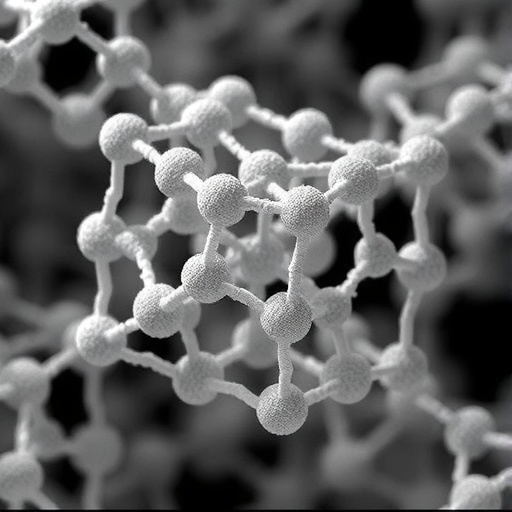In the rapidly evolving field of materials science, the development of efficient electrocatalysts for renewable energy applications has garnered significant attention. A recent groundbreaking study published in the journal Ionics unveils a novel nanocomposite created from reduced graphene oxide (rGO) and molybdenum disulfide (MoS2). This innovative material demonstrates remarkable performance in the oxygen evolution reaction (OER), a crucial process in electrochemical energy conversion devices like water electrolyzers and fuel cells. The implications of this research could pave the way for sustainable energy solutions that are not only efficient but also cost-effective.
The authors of the study, Razzaq et al., have made significant strides in addressing the urgent need for high-performance electrocatalysts. Traditional OER electrocatalysts often suffer from issues like high overpotentials and slow kinetics, hindering their efficiency. This new rGO-based MoS2 nanocomposite promises to overcome these hurdles. By leveraging the unique properties of both rGO and MoS2, the researchers successfully synthesized a material that exhibits enhanced catalytic activity. The inherent electrical conductivity of rGO combined with the active catalysis sites provided by MoS2 creates an ideal synergy for improved electrochemical performance.
In their research, the team employed a hydrothermal method to fabricate the rGO-MoS2 nanocomposite, ensuring optimal dispersion and interaction between the two components. This innovative approach not only resulted in high surface area and porosity but also facilitated the formation of active sites that are essential for the OER. The characterization techniques used, including X-ray diffraction (XRD), scanning electron microscopy (SEM), and transmission electron microscopy (TEM), confirmed the successful integration of rGO and MoS2 at the nanoscale, which is crucial for the high efficiency of the resulting electrocatalyst.
The electrochemical performance of the rGO-MoS2 nanocomposite was evaluated through a series of tests. The results demonstrated an impressive reduction in overpotential, indicating that this nanocomposite requires less energy to initiate the OER compared to conventional catalysts. This efficiency was further substantiated by the Tafel slope analysis, which revealed superior kinetics for the OER process. Such findings hold great promise for the practical application of this nanocomposite in various energy systems, from hydrogen generation to carbon capture technologies.
Beyond its performance metrics, the stability of the rGO-MoS2 nanocomposite under operational conditions is another noteworthy aspect of this research. Prolonged stability is crucial for any electrocatalyst intended for real-world applications, and the authors subjected their material to rigorous cycling tests. Remarkably, the composite retained its electrochemical activity and structural integrity over extended periods, suggesting that it could withstand the demanding environment of industrial applications.
The environmental and economic implications of adopting this enhanced electrocatalyst are profound. As the world moves towards greener energy sources, the demand for efficient OER catalysts is expected to skyrocket. The rGO-MoS2 nanocomposite not only provides a pathway to more effective catalytic processes but also uses materials that are comparatively abundant and environmentally friendly. This alignment with sustainability goals highlights the study’s relevance in the context of global energy needs.
Moreover, this research opens new avenues for further exploration in the field of nanocomposites. While the focus has primarily been on the rGO-MoS2 combination, the methodology laid out by Razzaq et al. could inspire the development of other hybrid materials using different transition metal dichalcogenides (TMDs) or conductive support matrices. Such explorations could yield a wide variety of catalysts tuned for diverse electrochemical reactions, expanding the toolkit available for renewable energy technologies.
The excitement surrounding this research is palpable within the scientific community. The paper not only presents compelling findings but also contributes to the broader dialogue around energy sustainability and innovation. The potential impacts extend beyond academia as industries looking to reduce their carbon footprints and pivot towards renewable energy technologies can benefit greatly from advancements in electrocatalytic materials.
As researchers worldwide dissect these findings, discussions around the scalability of producing the rGO-MoS2 nanocomposite will be just as crucial as its performance in laboratory settings. Producing these materials on a commercial scale while maintaining performance and cost-effectiveness remains a challenge that must be addressed. The insights gained from this study will undoubtedly steer further research in optimizing production processes and assessing the viability of the nanocomposite in real-world applications.
Furthermore, the integration of such advanced materials into existing energy frameworks poses additional questions. For instance, researchers will need to confront the challenges of substrate compatibility and the impact of operating conditions on the long-term viability of these nanocomposites. Aspects like corrosion resistance and the influence of impurities in electrolyte solutions are just as critical to making the leap from laboratory success to field practicality.
In conclusion, the groundbreaking study carried out by Razzaq et al. stands at the intersection of materials science and renewable energy. The rGO-MoS2 nanocomposite represents a significant leap forward in the search for effective electrocatalysts for the oxygen evolution reaction. With its exceptional performance metrics, stability, and potential for large-scale application, this research could serve as a cornerstone for future developments in sustainable energy technologies. It serves as an encouraging reminder of the innovative spirit within the scientific community, as researchers continue to strive for solutions that address some of the most pressing challenges of our time.
The journey toward sustainable energy, while fraught with challenges, is also filled with opportunities for innovation and progress. As the world increasingly looks for clean energy solutions, studies like this remind us of the incredible potential that exists in harnessing new materials and technologies. The race for high-performance electrocatalysts is just beginning, and the findings from this study will undoubtedly play a pivotal role in shaping the future landscape of renewable energy.
Subject of Research: Development of reduced graphene oxide-based MoS2 nanocomposites as electrocatalysts for oxygen evolution reaction
Article Title: Reduced graphene oxide-based MoS2 nanocomposite as an electrocatalyst with high performance for oxygen evolution reaction.
Article References: Razzaq, K., Alharabi, F.F., Gassoumi, A. et al. Reduced graphene oxide-based MoS2 nanocomposite as an electrocatalyst with high performance for oxygen evolution reaction. Ionics (2025). https://doi.org/10.1007/s11581-025-06629-y
Image Credits: AI Generated
DOI: https://doi.org/10.1007/s11581-025-06629-y
Keywords: MoS2, reduced graphene oxide, electrocatalyst, oxygen evolution reaction, renewable energy, nanocomposite




